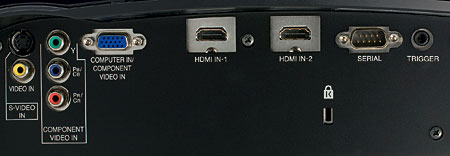Mitsubishi HC7000 LCD Projector
 Price: $3,995 At A Glance: Outstanding video processing, including full-time anamorphic lens support • Razor-sharp images • Color accuracy needs work
Price: $3,995 At A Glance: Outstanding video processing, including full-time anamorphic lens support • Razor-sharp images • Color accuracy needs work
Mitsubishi Delivers a Diamond
The HC7000 is Mitsubishi’s flagship video projector and one of only two Diamond Series projectors. This three-chip design uses the latest C2 Fine inorganic LCD panels. It has a native resolution of 1,920 by 1,080 and features a proprietary polarizing filter designed to squeeze a bit more contrast and better uniformity out of the panels. At $3,995, the HC7000 is the most expensive projector in our roundup, and it has some great features. It includes a dynamic iris, Silicon Optix HQV video processing, and a great warranty program for the projector and lamp. It also has full anamorphic lens support, including the ability to permanently mount the lens to the projector. Combined with the great build quality and performance, these features made the Mitsubishi my favorite projector of the group.

Design
The HC7000 comes in a very slick case. At first, it appears to be jet black, but on closer inspection, you’ll notice a blue flake finish that adds a nice touch to the overall aesthetics. On top, a flip-open panel hides the basic controls for power, menu operation, and lens control. The HC7000 is the only projector in the bunch with fully motorized lens control. It provides powered focus, zoom, and lens shift operation.
The top panel partially obscures the rear panel to hide those unsightly cables. This makes installation pretty, but it also makes it hard to see exactly where to plug in the connectors. I wish Mitsubishi had included a small light on the back of the HC7000.
The rear panel has a decent complement of video connections, including two HDMI 1.3 connections as well as one component video, one S-video, and one composite video input. It also includes a single RBG pin input to connect your computer. You could also use it as a second component video connection with a breakout cable. For custom installation, Mitsubishi also provides a trigger output and an RS-232 connection.
The lens is recessed into the case and offers a 1.6x motorized zoom. The outer lens assembly is threaded, and internal video processing allows for full-time use of an anamorphic lens. Constant-height setups are becoming popular in home theaters. A lot of people like to eliminate the black bars that appear above and below 2.35:1 program material. In addition to special video processing to manipulate the image shape, these setups typically require additional hardware to move an anamorphic lens in front of the projector’s lens when it displays a 2.35:1 title. Mitsubishi has worked around this. The HC7000 includes scaling modes that let you permanently mount an anamorphic lens in front of the projector and scale the image based on the aspect ratio, so you never have to move it again. While this is convenient, it does have some disadvantages.

With a typical constant-height setup, the video processing that’s required to support the anamorphic lens only engages when you play a 2.35:1 source. With the HC7000’s setup, the lens is permanently in the optical path, so you won’t have that choice. You must always engage additional processing to compensate for the anamorphic lens. I didn’t have an anamorphic lens to use in this setup, but I did engage the required processing to test its general effect on the image quality. The Silicon Optix processing for this feature is quite good, but it induces some artifacts that take a small toll on the over-all image clarity and sharpness. You’ll have to decide for yourself if this benefit outweighs the artifacts.
The HC7000 may be the quietest projector I’ve ever used. Heat dissipates out of the right side of the projector, and I couldn’t detect any fan noise at all in the low lamp mode. Even in the high lamp mode, the projector was quieter than most projectors I’ve tested in low lamp mode. Noise will not be a concern, regardless of your seating distance from the projector.
Setup
The HC7000 has a pretty simple menu system that’s intuitive and easy to use. Most of the settings were easy to figure out, but a few of the selections were a bit confusing in terms of what they actually do for the image. I wish manufacturers would settle on some universal verbiage for image enhancements. It would make life a lot easier for both consumers and reviewers.
The projector offers three video memories, so you can set up different configurations for different program content or viewing conditions. For example, this makes it nice if you use the projector with some ambient light at times and with all the lights off at other times.
The Mitsubishi includes full gray-scale calibration options without having to access a service menu. Unfortunately, there aren’t any color management options, which would have come in handy given the projector’s rather poor colorimetry.
This projector uses a dynamic iris to achieve its high contrast ratio, which is becoming the norm in the LCD projector market. The HC7000 has no less than five different modes for its iris control, including Off. The modes generally pertain to the viewing environment or the age of the bulb in use. Mitsubishi is one of the only manufacturers that actually takes lamp life into account for the aggression of its iris. It’s nice to see that kind of attention to detail at this price point.
- Log in or register to post comments





























































